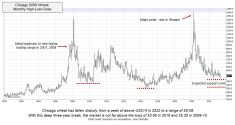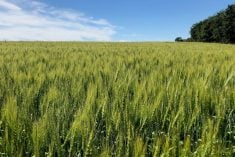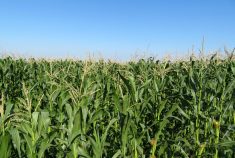During the second week of March, Ontario corn, soybean and wheat prices were trading near or at 52-week highs as domestic and export demand continues to exceed year-ago levels.
Quick look
Soybeans: Brazil’s soybean harvest lags year-ago levels.
Corn: Second crop corn planting in Brazil about 30 per cent behind last year’s pace.
Wheat: Wheat market could rise depending on whether there’s rain in Kansas in April.
Traders appear to be well-covered for their nearby commitments but the commercial system needs to draw stocks from the farmer in the deferred positions.
Read Also

Scouting advised for soybean aphids
Soybean aphids have been spotted in a few fields in southern Ontario that haven’t seen soybean aphids in quite a…
Planting intentions and weather forecasts will dominate market news over the next month. Given the tighter soybean and corn stocks in North America, prices will be very sensitive to crop developments. Usually, there is a surge in farmer selling during June and July.
The Brazilian soybean harvest continues to lag year-ago levels as does planting of the safrinha, or second, corn crop.
Argentine corn and soybean crops are expected to experience yield drag due to drier conditions late in the growing season.
The United States Department of Agriculture is expected to release its seeding intentions report for U.S. corn and soybeans on March 31. This is the most important USDA report of the year.
Strength in the crude oil and energy markets have lifted all commodities in the short term. Stronger biodiesel values have spilled over into the vegetable oil complex.
China appears to be experiencing a resurgence in African swine fever but the extent of the problem is uncertain.
Brazilian soybeans are trading at a discount to U.S. origin out of the Gulf of Mexico and Argentine corn is discount to U.S. corn.
Media reports suggest the COVID pandemic in Brazil is out of control and this could interrupt logistics and port operations.
The Canadian dollar continues to trade within the long-term range with support around the 77.50 U.S. cents area, and resistance at the psychological level of 80 U.S. cents. Canadian and U.S. bond yields continue to percolate higher with improving investor confidence in the longer-term economic recovery. Inflation is becoming more of a concern and the risk premium is becoming more concrete with the ongoing fiscal stimulus packages.
Soybeans
Canadian crop-year-to-date soybean exports for the week ending Feb. 28 were 3.4 million tonnes, up from 2.4 million tonnes last year.
Canadian domestic disappearance for the week ending Feb. 28 was 944,100 tonnes, up 63,000 tonnes over year-ago levels. European demand for Ontario soybeans is coming in larger than earlier anticipated, which is the main driver of the Ontario market.
Domestic basis levels have improved over the past month. Farmer selling tends will slow during planting but then increase in the final quarter of the crop year.
Ontario soybeans have been competitive on the world market through winter but Brazil will likely dominate European demand moving forward.
All eyes are on Brazil in regards to the soybean market. The soybean harvest is only 30 per cent complete, down from nearly 50 per cent last year. Adverse rains have hindered harvest progress and port loading. We’re seeing a bottleneck in logistics and port loading. The problem could be amplified if constraints are implemented due to the COVID pandemic.
The crop size has become a secondary issue, although trade estimates are still confirming the USDA number of 133 million tonnes, up from 126 million tonnes last year.
The Argentine soybean harvest will move into full swing during April. Traders are expecting downward revisions to the USDA estimate of 48 million tonnes, which is down from last year’s output of 49 million tonnes. The Argentine soybean crop was rated 15 per cent good to excellent in early March, down from 64 per cent last year.
U.S. soybean stocks will drop to bin bottom levels at the end of the 2020-21 crop year.
Canadian prices have improved over the last month to slow exports south of the border. The Canadian soybean market is rationing demand to slow exports.
What to do: We’ve advised Ontario farmers to be 100 per cent sold on old crop and 20 per cent sold on expected new crop production. We’re expecting an 8.5 per cent increase in U.S. soybean acreage this spring and a 10 per cent increase in Ontario soybean planted area. We don’t feel the market will fall apart.
The futures have potential to incorporate a risk premium due to the uncertainty in North American production. Stocks are tight so the market cannot afford a crop problem.
Corn
Ontario elevator corn bids have been relatively flat over the past month. Canadian crop year-to-date corn exports for the week ending Feb. 28 were 520,200 tonnes, up from 12,500 tonnes last year. While exports are exceeding year-ago levels, offshore movement has slowed during the past couple months due to the lake closure.
We’re also seeing stiffer competition with Argentine corn trading at a discount to U.S. and Canadian origin.
Ontario cattle-on-feed inventories are at seasonal highs but will decline from April through July. Unless we see demand improve, it will be difficult to see further upside in the corn market.
Brazil’s first crop corn harvest is about 45 per cent complete. However, the major concern is the seeding of the larger second crop corn. Farmers have only planted 40 per cent of the safrinha corn crop compared to 67 per cent last year.
There has been little progress over the past couple weeks. It now looks like most of the second crop corn will move through the key pollination phase when there is extensive heat and limited precipitation.
The Argentine corn harvest is in full swing and farmers should make good progress over the next month. Argentine corn offers are a US$10 per tonne to US$15 per tonne, discount to U.S. origin out of the Gulf in the short term. However, we continue to hear of steady demand from China for U.S. corn. The problem is reliability of loading and ocean freight spreads.
We feel that U.S. corn will move back to equilibrium with Argentine origin later in spring. The delay in the Brazil’s second crop planting will keep the U.S. as the dominant market influence into the early summer period.
U.S. farmers have been aggressive sellers through the winter. Moving into spring, resistance from farmer selling will ease. This could allow the market some breathing room, if Chinese demand steps forward on a large scale.
We’re looking for a year-over-year increase in U.S. corn acres but this is not a slam dunk. If the USDA shows a year-over-year decrease in corn acreage on March 31, we could see the corn market trade 50 cents per bushel higher, quite easily.
What to do: We’ve advised farmers to be 80 per cent sold on their 2020 production. We’ll be patient to make our next sales recommendation.
Wheat
The wheat market is in a unique situation. March and April are typically bearish periods for wheat. This year is different for three main reasons:
- The stronger corn and coarse grain market in general has held up wheat prices in Canada, the U.S. and Europe;
- The Russian export tax and Ukraine export controls have underpinned the world wheat market;
- Major exporters will experience tighter ending stock for the 2020-21 crop year. China is contending with a food shortage and could be a major buyer of wheat through the summer if drier conditions materialize in their winter wheat area.
Moving forward, the focus will slowly turn to Northern Hemisphere new crop production.
France reported winter wheat conditions at 88 per cent good to excellent, up from 67 per cent last year. Europe is contending with historically tight old crop stocks but conditions are favourable across the European Union at this time. In the U.S., the hard red winter wheat region is on the drier side as the crop comes out of dormancy.
However, the critical month is April, which is when seasonal rains come across Kansas. This is when the hard red winter crop is made.
Most of Manitoba and Saskatchewan have received less than 40 per cent of normal precipitation over the past 60 days.
The U.S. northern plains are also on the dry side heading into seeding period. Timely rains will be needed for North American spring wheat.
Russia and Ukraine conditions are mostly favourable at this time. Crop development in Russia is about one month behind the U.S hard red winter wheat crop, so the critical period is May and June.
What to do: We’ve advised producers to be 80 per cent sold on their 2020 production. We’re going to be patient to make our final sales recommendation in the short term.
If we don’t see the seasonal rains develop in Kansas in April, then we could see the wheat market strengthen. We’ll watch Northern Hemisphere conditions to plan our final sale.















